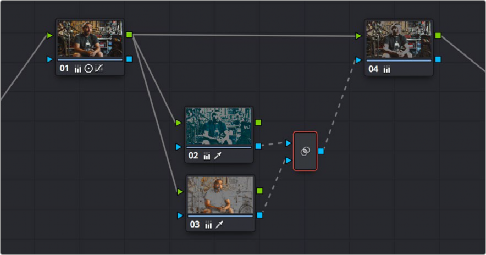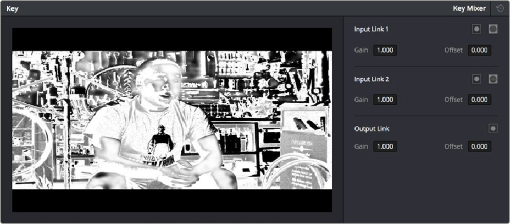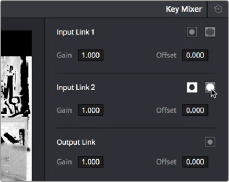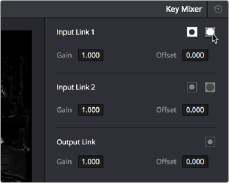
< Previous | Contents | Next >
Final grade, the talent in color with a B&W background
Subtracting One Key from Another
The way multiple keys are combined within the Key Mixer depends on a pair of Key Input buttons you can toggle using the Key palette. In the following example, a partial green tint is washed throughout the midtones of the image using a qualifier, but you want to exclude the man’s skin tone from this operation. Using the Key Mixer, you can subtract one key from another to accomplish this with ease.

A selective blue tint added to the midtones of the image includes the red sign.
![]()
1 In this example, Node 2 is isolating part of the midtones of the image, and feeding its key through the Key Mixer to Node 4, which is using it to apply a partial blue tint. However, in preparation for subtracting the skin tone from this operation, Node 3 is isolating the man’s skin tone.

A node setup in preparation of subtracting the Bar sign from the midtone isolation being used to add a partial blue tint
2 To reveal the controls you’ll use to change how the key from Node 3 interacts with the key from Node 2, double-click the Key Mixer node to select it.
3 Open the Key palette; a list of all input links that are connected to the Key Mixer appears at the right.

The input list of the Key Mixer node
4 Within each list entry is the input name (Input Link 1, Input Link 2, etc.), a Matte control, a Mask control, a gain parameter, and an offset parameter.
— To subtract Node 3’s key from that of Node 2: Turn on both the Key Input Matte button and the Key Input Invert button for Input Link 2.

![]()
Turning on Matte and Invert for Input Link 2 to Output Node 3 subtracted from Node 2
— To subtract Node 2’s key from that of Node 3: Turn on both the Key Input Matte button and the Key Input Invert button for Input Link 1.

Turning on Matte and Invert for Input Link 1 to Output Node 2 subtracted from Node 3